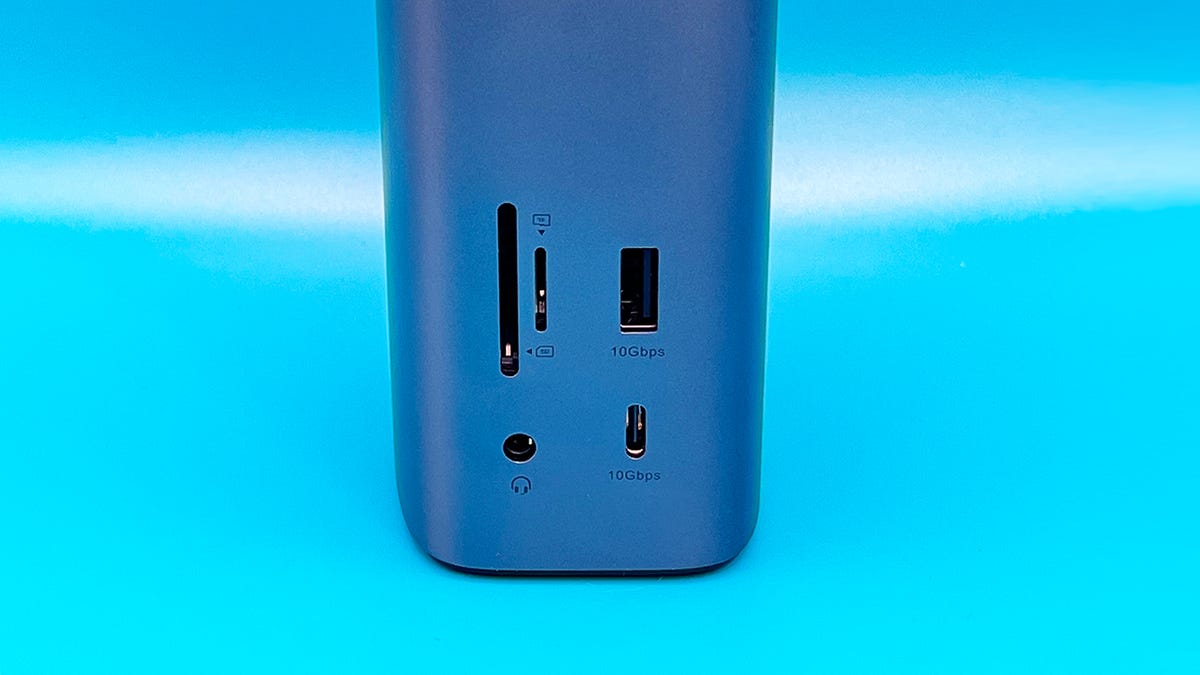Your M1 Mac can have three displays at last with this Ugreen docking station

The front-facing ports include a 10Gbps USB-A 3.2 Gen 2, 10Gbps USB-C 3.2 Gen 2, headphone/microphone combo, and a pair of SD/TF card reader slots. Michael Gariffo/ZDNET
Anyone who’s used a MacBook or any USB-C-only laptop is likely to be familiar with “dongle life.” While we wait for the rest of the world to USB-C-ify everything, we often have to resort to a series of adapters to help along our older or less compatible peripherals and displays.
Many M1 Mac users have run also into the unfortunate headache of realizing their multimonitor ambitions have been foiled by Apple limiting the M1 chip to just a single monitor (in the case of MacBook) or two displays (if they have an M1 Mac Mini).
While I recently featured a Thunderbolt 4 dock from Accell (Thunderbolt being a very fast and versatile type of USB-C) that can solve all of these problems for Windows PC users, that excellent unit still lacked the one feature that could have made it as versatile for M1 Mac users.
This option from Ugreen remedies that deficiency by adding DisplayLink support, making it possible for your M1 to do things even Apple never intended. Let’s take a look at why this combination of features makes the Ugreen USB-C Multifunction Docking Station an ideal companion for your Mac or Windows PC.
The Ugreen Multifunction Docking Station Pro offers a total of 12 ports between its array of front and rear connections. Like most USB-C docking stations, it provides a quick way for you to turn your laptop into a full-fledged desktop workstation by plugging in just one cable.
Also: Slow internet at home? This adapter lets you repurpose cable for better connectivity
The front-facing ports (shown above) include the one 10Gbps USB-C port you’re most likely to use as a connection point for your laptop. However, you also have quick access to a headphone/mic combo port, an SD/TF card reader, and an extra USB-A port for those pesky mice, keyboards, or other peripherals that stick to the older standard.
The rear of the device is where you can hide the tangled mess of cables we all know you’re ashamed of. Michael Gariffo/ZDNET
Around back, the docking station includes the following ports:
- Two 5Gbps USB-A ports for peripherals like mice, keyboards, webcams, and printers
- One USB-C 3.2 Gen 2 10Gbps port for connecting a laptop or other device in the rear
- One PD 3.0 20V/5A backward-compatible power delivery port where you can connect your laptop’s included USB-C power adapter or other power source
- One Gigabit Ethernet port
- Three video output ports: one HDMI 8K @ 30Hz (backward-compatible to 4K @60Hz), one HDMI 4K @60Hz, and one DisplayPort (DP) 4K @60Hz
All of this translates into the ability to run a triple display setup with a hard-wired LAN connection, a bevy of USB-C and USB-A peripherals, and power, all through a single, included Thunderbolt 4 cable. You will have to provide your own power adapter, which isn’t ideal if you don’t already have a USB-C-based one from your laptop. MagSafe-based MacBook owners and Mac Mini users, for instance, will likely need to purchase a third-party USB-C charger that says it’s compatible with their model of laptop.
The dock includes a single (~1 meter) Thunderbolt 4 cable that you can use to connect your system. Michael Gariffo
At this point, you may be saying, “Waitaminute… my M1 MacBook/Mini can’t support a triple-monitor setup, so what’s the point?” Normally, that would be true. However, that’s where DisplayLink comes in. This technology allows you to run additional monitors on almost any Windows or MacOS system by creating what are essentially virtual GPU (video card) outputs.
In the case of the M1 MacBook Air and M1 Mac Mini I tested this dock with, the installation process consisted of installing a driver from the Synaptics (makers of DisplayLink) website. Once the quick installation was completed, I tested both HDMI and DP displays in a variety of resolutions. All of them appeared, without trouble, in the standard Display section of the MacOS Settings app, with no discernable difference between them and the monitors connected natively through either Mac’s singular Thunderbolt video output, or the Mac Mini’s lone HDMI output. It really was surprisingly simple.
The device is reassuringly heavy to prevent wires from pulling it around. Despite the weighty construction, it’s still only about 3 by 2.25 by 5.25 inches. Michael Gariffo/ZDNET
Of course, the Ugreen Multifunction Docking Station Pro is by no means the cheapest solution. You could accomplish most of the same things by spending considerably less on a combination of several individual adapters, dongles, and cables. But, a large part of what you’re paying for here is the extreme convenience this singular, monolithic unit provides. It’s meant to be a single home for all of your connection and adaptation needs, and it did the job very well in my testing.
When you hit your desk after a long, tiring day and you only need to plug in that lone cable to connect to a dozen or so peripherals, that money you spent on this will start to feel well worth it. This is even more true for the M1 Mac users who might otherwise struggle to reach their full setup goals without a DisplayLink-enabled adapter like this one.
For all the latest Technology News Click Here
For the latest news and updates, follow us on Google News.
